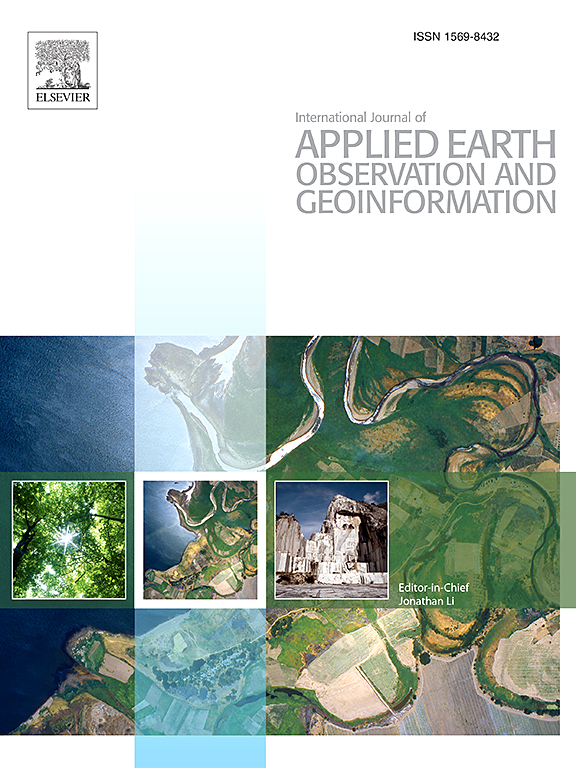基于无人机多光谱和DSM数据的直立玉米秸秆提取
IF 8.6
Q1 REMOTE SENSING
International journal of applied earth observation and geoinformation : ITC journal
Pub Date : 2025-05-28
DOI:10.1016/j.jag.2025.104622
引用次数: 0
摘要
秋冬季节留在田间的直立玉米秸秆燃烧造成了农业生态系统的严重空气污染。快速准确地获取直立玉米秸秆的空间分布对有效管理和环境保护至关重要。然而,利用遥感技术识别直立玉米秸秆是困难的,因为其光谱特性与秸秆秸秆、裸土和稀疏小麦等其他土地覆盖物在同一时期的光谱特性相似。利用低成本无人机(UAV)可见光至近红外波段与数字表面模型(DSM)数据相结合,提出了一种提取直立玉米秸秆的新指标。首先,分析了直立玉米秸秆、秸秆秸秆、裸土和稀疏小麦4种土地覆被类型的光谱特征,提出了利用绿、红、红边带的调整秸秆指数(ASI)。接下来,我们将DSM数据与ASI数据相结合,建立了考虑直立玉米秸秆高度的调整秸秆高度指数(AHSI)。最后,将指数+ otsu阈值分割与随机森林(RF)方法相结合,对直立玉米秸秆的空间分布进行识别和提取。结果表明,该方法能有效地检测出玉米秸秆直立生长的主要区域。在三个不同的研究区域,两种稻草指数的提取精度分别超过87%(ASI)和96%(AHSI)。这两个新指标不仅显著提高了直立玉米秸秆的识别精度,而且为基于无人机的低成本非光合植被(NPV)识别提供了新途径。本文章由计算机程序翻译,如有差异,请以英文原文为准。

Extraction of the upright maize straw by integrating UAV multispectral and DSM data
Upright maize straw left in the field during autumn and winter significantly contributes to severe air pollution in agricultural ecosystems due to burning. It is essential to obtain the spatial distribution of upright maize straw quickly and accurately for effective management and environmental protection. However, identifying upright maize straw using remote sensing is difficult because its spectral properties resemble those of other land covers like straw residue, bare soil, and sparse wheat at the same period. This study proposes a novel index for extracting upright maize straw by integrating low-cost unmanned aerial vehicle (UAV) visible to near-infrared spectral bands with digital surface model (DSM) data. First, we analyzed the spectral characteristics of four land cover types: upright maize straw, straw residue, bare soil, and sparse wheat, and proposed the adjusted straw index (ASI) that leverages green, red, and red-edge bands. Next, we combined DSM data with the ASI to develop the adjusted height straw index (AHSI), considering the height of the upright maize straw. Finally, the combination of index-plus-Otsu threshold segmentation and random forest (RF) methods was applied to identify and extract the spatial distribution of upright maize straw. The results showed that our method effectively detected the main regions of upright maize straw. The two proposed straw indices achieved over 87%(ASI) and 96%(AHSI) extraction accuracies across three different study regions. The two new indices not only significantly improve the accuracy of upright maize straw identification but also provide a new approach for low-cost UAV-based identification of non-photosynthetic vegetation (NPV).
求助全文
通过发布文献求助,成功后即可免费获取论文全文。
去求助
来源期刊

International journal of applied earth observation and geoinformation : ITC journal
Global and Planetary Change, Management, Monitoring, Policy and Law, Earth-Surface Processes, Computers in Earth Sciences
CiteScore
12.00
自引率
0.00%
发文量
0
审稿时长
77 days
期刊介绍:
The International Journal of Applied Earth Observation and Geoinformation publishes original papers that utilize earth observation data for natural resource and environmental inventory and management. These data primarily originate from remote sensing platforms, including satellites and aircraft, supplemented by surface and subsurface measurements. Addressing natural resources such as forests, agricultural land, soils, and water, as well as environmental concerns like biodiversity, land degradation, and hazards, the journal explores conceptual and data-driven approaches. It covers geoinformation themes like capturing, databasing, visualization, interpretation, data quality, and spatial uncertainty.
 求助内容:
求助内容: 应助结果提醒方式:
应助结果提醒方式:


